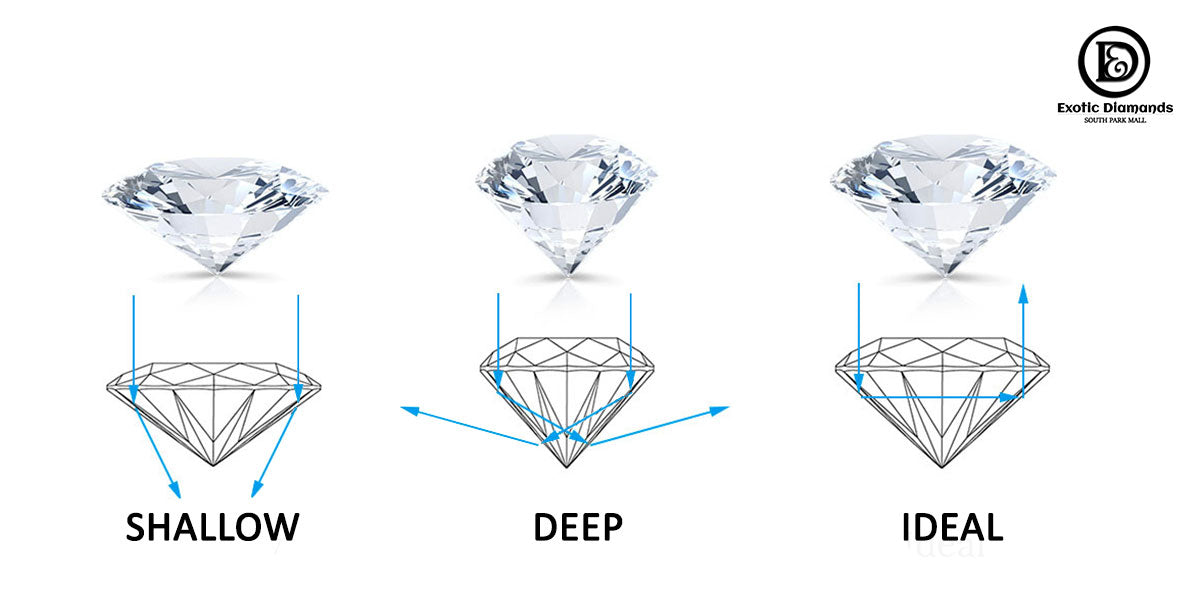Sep 09 , 2020
Diamond Cut
Diamond Cut - Introduction
A diamond’s cut is the most important among the 4Cs of a diamond. It is often confused with the diamond’s shape (round, oval, princess, etc) but a diamond’s cut is in fact the proportions and the symmetry of its facets. It plays the pivotal role of imparting a diamond with its brilliance, fire and scintillation. Owing to this the beauty and the price of a diamond is primarily depended on its cut.
The Perfect Diamond Cut for Your Budget
Buying the most sparkling diamond under your budget is a no brainer. Nobody wants to shop for a dull looking diamond. As aforementioned a diamond’s sparkle depends entirely on its cut; this in turn makes the diamond more beautiful. Adiamond free of all blemishes and inclusion (FL clarity grade) might still appear
dull if the cut is not optimum i.e. is not too shallow or too deep. Therefore, when buying a diamond it’s crucial to choose the best cut grade diamond that you can afford.
Exotic Diamonds has a Cut Grade Parallel to the GIA issued Cut Grade
The cut grade offered at Exotic Diamonds is similar to the cut grade rating issued by the GIA (Gemological Institute of America). We grade our diamonds on the premise of its sparkling i.e. reflection of white light by the diamond which is identical to that of the GIA Cut Grade. An Ideally Cut Diamond has Excellent Brilliance, Fire and Scintillation. Let’s get accustomed to the three light characteristics of an ideal diamond.
Brilliance: The brightness produced due to the white light reflection from the facets as well as the interior surface of the diamond.
Fire: Dispersion of white light into the spectrum of natural colours.
Scintillation: The sparkle produced due to the contrast between the dark and light areas.
The Parts of a Diamond
There are seven significant parts of a diamond.
Table: It’s the largest facet, present at the top of a diamond.
Crown: The top of the diamond between the table and the girdle.
Diameter: The width of a diamond from one girdle edge to the other.
Girdle: The widest edge of the diamond where the crown and pavilion intersect.
Culet: The facet at the bottom of the diamond.
Pavilion: The lower part of the diamond, stretching from the girdle to the culet.
Depth: The height of the diamond measured from the table to the culet.
Diamond Cut vs Diamond Shape
The terms Diamond Cut and Shape are time and again used synonymously by many but are actually two different characteristics of a diamond. A diamond cut is depended on the proportions, symmetry and polish of the diamond’s surface whereas the shape of the diamond is just the outline of its surface. Both factors have a contrasting effect on the beauty and price of a diamond.
All loose diamonds at Exotic Diamonds come with a GIA Diamond Grading Report
Each loose diamond at Exotic Diamonds undergoes an unbiased analysis by the Gemological Institute of America which is one of the most credible labs within the diamond industry. Since its foundation in 1931, this non-profit laboratory has been working earnestly in the field of gemology and jewellery arts. It has a
nonpareil reputation in the industry.
GIA graded diamonds are regarded highly in the diamond industry. We at Exotic
Diamonds affirm to selling only the best quality diamonds to our customers.
Thus, all our diamonds come with a GIA Diamond Grading Report.
The GemEx Brilliance Scope Analyser to test a Diamond’s Light Performance
No two diamonds have the same brilliance in spite of optimal proportions. There is always variability in their light performance even if it’s by a fraction. Consequently, diamonds have to be assessed for their light performance to be priced accurately. GemEx Brilliance Scope Analyzer is a patented system that
utilizes spectrophotometer technology to examine the light performance of two diamonds with the same shape.










